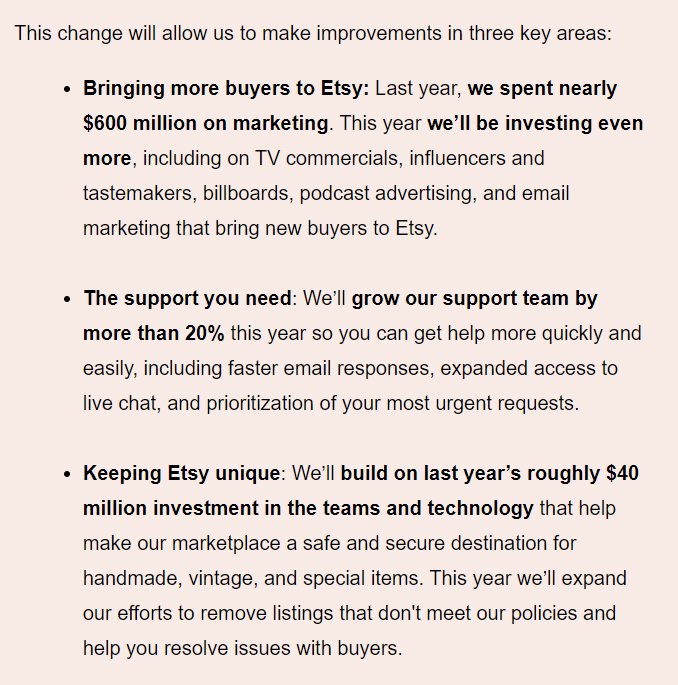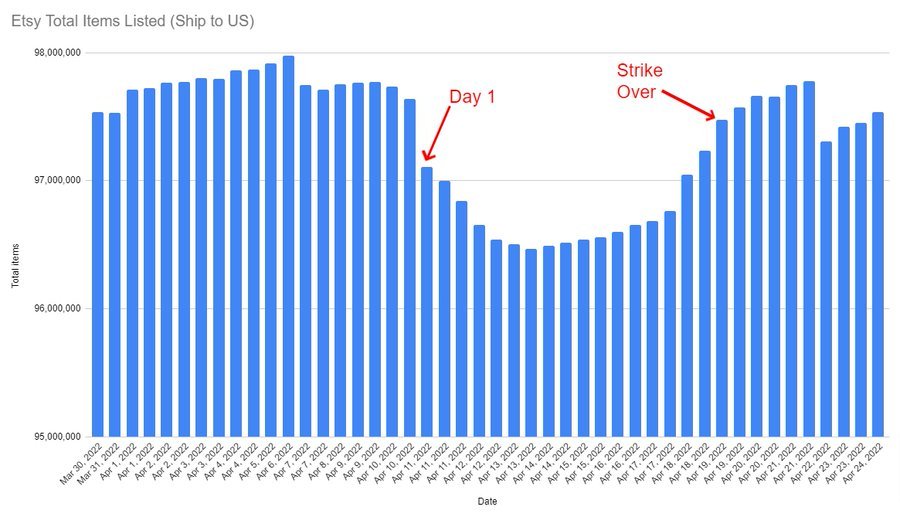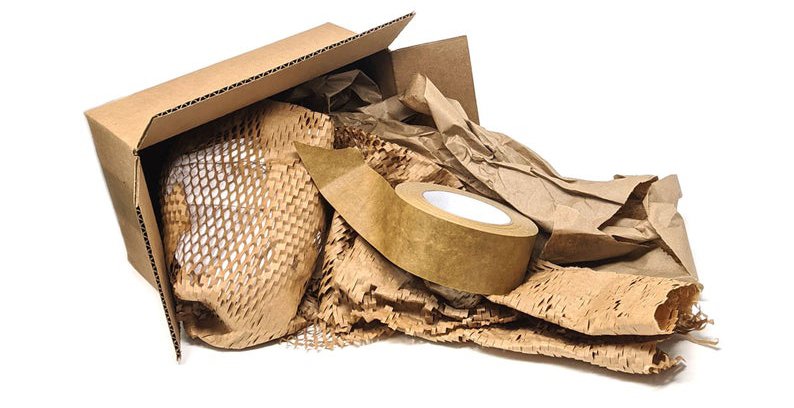It’s been a little over a week since the Etsy seller strike ended, and you may know that I had some thoughts before it started. So, did the strike have any notable results? Well, there are data points we can analyze, anecdotal opinions we can discuss, and reflections from my own experience and how I’m changing my Etsy strategy going forward. You can also jump to the end to see my suggestions for small business sellers and customers.
Etsy’s Response
Etsy did not reach out to the strike’s organizers directly. Instead, a bottled response was repeated to the press:
“Sellers have consistently told us they want us to expand our efforts around marketing, customer support and removing listings that don’t meet our policies. Our revised fee structure will enable us to increase our investments in each of these key areas so we can better serve our community and keep Etsy a beloved, trusted and thriving marketplace.”
This response is in-line with the original email sent to sellers by Etsy on February 24th, and lightly touches on two of the strikes demands: cracking down on resellers and improving seller support. Etsy will need to make good on these promises, but the strikers are not optimistic. They are continuing their efforts with a letter writing campaign and possibly a union-like “solidarity organization for Etsy sellers.”
Excerpt from Etsy’s email titled “Investing in Etsy’s growth: A message from CEO Josh Silverman” on February 24th, 2022
The News
The general Etsy Strike press release could be found on almost every major news provider. As the week continued, some sites tracked the progress and added interviews from various Etsy sellers. You can check out an archive of the news coverage here. I saw a couple interesting spins on the story, like this article that focused on Etsy as an entrepreneurship entry point for women and non-binary business owners. By bringing the strike to the attention of people who never knew it was brewing, news outlets helped to influence the public’s opinion of Etsy - but more on that in a bit.
One news-worthy development was the tweet by Etsy founder, Rob Kalin, supporting the strike - his first tweet in 7.5 years.
The Numbers
First, let’s look at signatures. When I released my Etsy Strike article on April 7th, the strike petition had around 33,000 signatures. Now, it has over 85,000 with at least 30,000 of those claiming to be Etsy sellers themselves.
One Etsy seller tracked an interesting number change during the strike - the total number of items listed for sale on Etsy. With so many Etsy sellers putting their shops on “vacation mode” during the strike, the number of items available for sale dropped notably, but you can also see that the item number has mostly recovered. Some shop owners closed their Etsy’s permanently, but the remaining sellers are mostly making up for it.
So what about stocks? The catalyst for many seller complaints is the moment that Etsy went public - turning its concerns from small businesses to stockholders. So have the stockholders been impacted? I looked to Google to pull the stock history for Etsy over the past month, year, and five years. Each graph tells a little different story. The five year chart obviously shows the jump in stock value starting in 2020 - the pandemic profiteering cited by the strike organizers. Looking at the past year, we see an understandable increase around the holidays, and a small jump after the fee increase announcement. A closer look at the last month shows a general downward trend, with a small spike after the strike ended. We’ll have to keep an eye on the continued path to see if a loss of sellers and a drop in public opinion will have any long term impact on stock values.
Public Opinion
Even before the Etsy strike I’d noticed an increase in negative comments about Etsy. As the strike approached, I talked with other artists who noted concern that people would boycott Etsy permanently. These artists are dependent on Etsy’s marketplace searchability, sales tax collection, and VAT handling to easily (and legally) sell overseas, so leaving is not an option. Even the strike organizers recognize that there is no one-to-one alternative to Etsy. Of course, my perception of public opinion is also skewed by my social media bubbles. When I shared my strike blog post on some local artist FB groups, I found that many of the sellers there hadn’t heard anything about the strike. This was a surprise in comparison to my TikTok “for you page” where almost every other video was about the strike. During the strike, I also read a comment thread from an Etsy YouTuber where many of the commenters were not participating in the strike, didn’t know about it, or were even poking fun at it.
However, I do think the behind-the-scenes realities of Etsy are becoming more known within the art-collecting and small-business-buying communities. In 2018 when I wrote about Etsy fees, many of my Instagram followers did not know how Etsy worked, and 60% said that they preferred shopping on Etsy instead of an artist’s personal site. I have not redone this poll yet, but when posing a similar question to TikTok, many more commentors seemed willing to buy from an artist’s site, and there was also much heavier criticism of Etsy. Here are a few of the comments on recent TikTok videos:
Selling Online is NOT One-Size-Fits-All
One question that has been in the back of my head through all of this is: What are the business models of those most opposed to the fee increases versus those less bothered by it? Obviously, no one likes to pay more money, but I’ve expressed my belief that the fees are still worth the services provided by Etsy (so far.) I think it is important to note that my business exists online and offline, and before 2020, most of my sales were at in person events. Generally, for a craft show to be considered “good,” you are aiming for the booth fee to be about 10% of your sales - and you are still paying the same 3% credit card processing fees as selling online. Selling in a store usually means a consignment or wholesale cut of 30% - 50%, so 6.5% from Etsy isn’t detrimental to my bottom line. I also sell larger items - mugs, bottles, and sculptures that are just naturally priced higher than say, stickers. A lot of the fee complaints I have seen come from small item sellers like stickers and pins, which seem to just naturally have smaller profit margins, so I can imagine how an online-only seller might not have the wiggle room for a 1.5% increase. Though, I think charging accurate shipping has a huge impact on keeping online sales profitable. Etsy might not be the best match for every business type, but all platforms come with their pros and cons. I’m curious if the strike’s biggest supporters come from sellers who have only ever sold online, and if there are trends between product type, age of sellers, or even age of businesses - I think a comparison of demographics versus opinions would be so interesting to see.
My Strike Experience
During the week of the strike, I did not close my Etsy shop, but I did change all my shop links to my Pattern site. I started my Pattern free trial in April, so I was not paying Etsy for its use, and chose to direct all my traffic there. However, in my current business model, I do most of my marketing and make most of my sales around restocks. I didn’t have any new product to push that week, so I wasn’t pushing a lot of traffic regardless. What did happen, though, was that I made two passive orders through Etsy. In fact, ever since opening my Pattern shop and trying to direct my traffic there, I have been able to more clearly see which sales come from my own efforts, and which are sourced by Etsy. This realization has led to a change in strategy. (You can read more about Pattern in my last blog post.)
My New Shop Policy
I still really like the user-friendly backend of Etsy listings, shipping, and customer communication (minus the pressures of the Star Seller program of course,) but I wouldn’t mind getting to keep a little more of my hard earned sales. So, I’m trying something new with my Pattern site:
Pottery restocks will release exclusively to my Pattern site. Etsy customers can still buy from Pattern and see the purchase in their Etsy history. Etsy coupons also still work on Pattern, so the buyer experience is pretty much the same as on Etsy. The difference is that I get to skip the $0.20 listing fee and the 6.5% transaction fee on these sales.
After one week, any remaining stock will be added to Etsy. Purchases can still be made from Pattern or Etsy, but this will allow the items to be discovered on Etsy search. (Once added to Etsy, the $0.20 listing fee will be charged and sales made on Etsy will take the 6.5% transaction fee.)
I’m hoping this approach will be a "best of both worlds” scenario - maximizing my earnings from self-directed traffic, but using Etsy’s marketplace to sell the pieces that aren’t immediately scooped up.
Make sure to sign up for my emails if you want to be notified of restock times - like my upcoming Seconds Sale!
My Advice for Other Artists
On my first strike post, I talked about how using the free trial of Pattern might help you test the waters of sales without Etsy, or at least give some wiggle room while building a new site. But what are some other things you can do to boost sales in the future?
Diversify your social media presence - Putting all your content eggs in one social media basket can mean trouble when algorithms change and your engagement drops. Do you have to be an expert at every platform? No. I know my attempt at joining Twitter has been sorely lacking. But, it is good to expand your audience to at least two or three apps so you can hit the different markets that exist on each. I’m still trying to find the right way to harness Pinterest as an artist, but my pinned Ren Faire blog is consistently one of my most viewed webpages - now I just need to keep jugs in stock to catch the traffic.
Build that email list - If you follow any small business tip creators, you’ve probably seen this advice, but I’m here to reiterate it again. Email inboxes are one of the most direct ways to reach your customer base, and they can’t be changed by an algorithm. Customers that opt-in to emails are likely your most loyal and interested, so make sure you market to them. You can offer sign up rewards like discounts, or long term bonuses - for example, I only announce the exact time of restocks to my email members so that they get an exclusive heads up on shop updates.
Find interest groups - Facebook groups saved my business in 2020. When Renaissance Festivals were cancelled, Faire Relief 2020 was formed, and I suddenly had access to over 50,000 members of my target market. I saw a direct correlation between my posts to that group and the sales that I made in 2020, 2021, and now. Communities of interest groups exist all over - Facebook, Reddit, Tumblr, not to mention interest specific websites. Find a few that relate to your work and try them out. Don’t necessarily focus on your medium - for example, I don’t think I would find much success in a “pottery” group filled with other potters, but I could find customers in a “mug collector” or “coffee lovers” group. What sort of things are your ideal customers into? Just make sure to read all the group rules - some don’t allow marketing posts on them.
How You Can Support Small Businesses For Free:
You understand the importance of small businesses and that buying from a small business makes your money go further (paying directly for groceries and housing rather than lining a CEO’s pockets.) But, sometimes you don’t have the money to spare to support all the businesses you wish you could. So what can you do?
Engage on social media - Social media is the easiest way for small businesses to reach potential customers, but sometimes the algorithm makes it not so easy. Every like, comment, save, and share you make helps to boost that artist’s post and get it in front of more eyes meaning more potential customers ready to buy. Plus, engaging means YOU will get to see that artist’s work more often too!
Create a bookmarks list on your web browser with the individual artist sites that you want to support - that way you have any easy reference point when you are ready to buy.
Subscribe and watch YouTube channels - Not every artist has a YouTube channel, but if they do, it’s an easy place to show your support! Did you know that channels need 1,000 subscribers and 4,000 watch hours before they can start making money from YouTube ads? I have a long, relaxing video you can pop on in the background to help your focus (and help my watch hours if you’d like.) I also post pottery videos and business tips!
Make a public list of your favorite artists - If you have any sort of a web presence, your list could help your favorite artists get discovered! Make a links page on your blog, or just be sure to tweet or post about your friends’ small businesses once in awhile. Word of mouth is one of the most powerful marketing tools! You can see a list of some of my favorite small businesses here.
Alternative Ways to Show Monetary Support:
As I said in my last post, I don’t think you should stop buying from artists just because they are on Etsy. But here are some other places artists might be accepting support.
Send a tip through Ko-fi, Cash App, Venmo, or PayPal. These links will likely be in an artist’s social media bio if they are accepting tips.
Shop from print on demand sites - illustrators especially will be likely to have Redbubble, Spoonflower, Society6, TeePublic, or other sites to print their artwork on various products and send them directly to customers. I don’t know the policies of any of these sites, so my apologies if any of these suggestions are problematic.
Join their Patreon pages - Patreon is a subscription style website that allows you to support creators by picking a monthly payment tier matched with certain rewards. My Patreon includes a secret store, product and restock polls, coupon codes, free shipping, surprise stickers, curated pottery gifts, and more! Providing a reliable income on Patreon can mean the world to an artist!
In Conclusion
If you made it this far - wow! Thank you for taking the time to read all my thoughts. I’d love to hear if you found anything especially helpful! Are there any other Etsy or business questions you would like answered?
Do I think a “New Etsy” is on the horizon? Not anytime soon. It would take a lot of work and industry knowledge to compete with Etsy as a household name. However, I do feel like there is a future for micro-marketplace communities. Creating a site to house every style of art and craft would be a massive undertaking, but creating purposeful collections of similar businesses can help one another flourish. I’ve found a lot of success on the FB group Faire Relief 2020. There are free websites like The Nile List, which is a searchable archive of Black-owned businesses. Do you know of other free marketplace websites? Unfortunately, in the wake of the Etsy strike I have seen several marketplace websites crop up with “small” fees, which can feel a lot like a scam without a promise of success. Be careful where you decide to join and evaluate if they will actually be of benefit to you.
Good luck to all the artists out there and THANK YOU to everyone continuing to support small businesses!


















